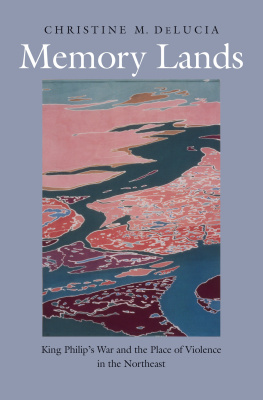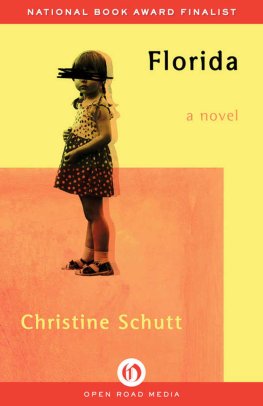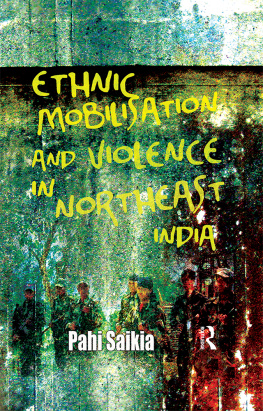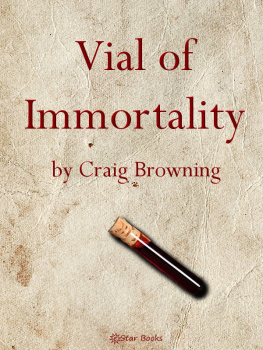Christine M. DeLucia - Memory Lands: King Philips War and the Place of Violence in the Northeast
Here you can read online Christine M. DeLucia - Memory Lands: King Philips War and the Place of Violence in the Northeast full text of the book (entire story) in english for free. Download pdf and epub, get meaning, cover and reviews about this ebook. year: 2018, publisher: Yale University Press, genre: Politics. Description of the work, (preface) as well as reviews are available. Best literature library LitArk.com created for fans of good reading and offers a wide selection of genres:
Romance novel
Science fiction
Adventure
Detective
Science
History
Home and family
Prose
Art
Politics
Computer
Non-fiction
Religion
Business
Children
Humor
Choose a favorite category and find really read worthwhile books. Enjoy immersion in the world of imagination, feel the emotions of the characters or learn something new for yourself, make an fascinating discovery.
- Book:Memory Lands: King Philips War and the Place of Violence in the Northeast
- Author:
- Publisher:Yale University Press
- Genre:
- Year:2018
- Rating:5 / 5
- Favourites:Add to favourites
- Your mark:
- 100
- 1
- 2
- 3
- 4
- 5
Memory Lands: King Philips War and the Place of Violence in the Northeast: summary, description and annotation
We offer to read an annotation, description, summary or preface (depends on what the author of the book "Memory Lands: King Philips War and the Place of Violence in the Northeast" wrote himself). If you haven't found the necessary information about the book — write in the comments, we will try to find it.
Memory Lands: King Philips War and the Place of Violence in the Northeast — read online for free the complete book (whole text) full work
Below is the text of the book, divided by pages. System saving the place of the last page read, allows you to conveniently read the book "Memory Lands: King Philips War and the Place of Violence in the Northeast" online for free, without having to search again every time where you left off. Put a bookmark, and you can go to the page where you finished reading at any time.
Font size:
Interval:
Bookmark:
M EMORY L ANDS
THE HENRY ROE CLOUD SERIES ON AMERICAN INDIANS AND MODERNITY
Named in honor of the pioneering Winnebago educational reformer and first known American Indian graduate of Yale College, Henry Roe Cloud (class of 1910), this series showcases emergent and leading scholarship in the field of American Indian Studies. The series draws upon multiple disciplinary perspectives and organizes them around the place of Native Americans in the development of American and European modernity, emphasizing the shared, relational ties between indigenous and Euro-American societies. It seeks to broaden current historic, literary, and cultural approaches to American Studies by foregrounding the fraught but generative sites of inquiry provided by the study of indigenous communities.
Series Editors
N ED B LACKHAWK
Professor of History and American Studies, Yale University
K ATE W. S HANLEY
Native American Studies, University of Montana

Published with assistance from the Louis Stern Memorial Fund and the income of the Frederick John Kingsbury Memorial Fund.
Copyright 2018 by Yale University. All rights reserved. This book may not be reproduced, in whole or in part, including illustrations, in any form (beyond that copying permitted by Sections 107 and 108 of the U.S. Copyright Law and except by reviewers for the public press), without written permission from the publishers.
The River Will Not Testify, from A MAYAN ASTRONOMER IN HELLS KITCHEN by Martn Espada. Copyright 2000 by Martn Espada. Used by permission of the author and W. W. Norton & Company, Inc.
Yale University Press books may be purchased in quantity for educational, business, or promotional use. For information, please e-mail (U.K. office).
Set in Scala type by IDS Infotech, Ltd. Printed in the United States of America.
Library of Congress Control Number: 2017940588
ISBN 9780300201178 (cloth : alk. paper)
A catalogue record for this book is available from the British Library. This paper meets the requirements of ANSI/NISO Z39.481992 (Permanence of Paper).
10 9 8 7 6 5 4 3 2 1
For all of my teachers, past and present
Of all Writings, those that are historical, specially while the things mentioned are fresh in memory, and the actors themselves surviving, had need be pursued with a wary pace.
William Hubbard, Colonial minister and historian at Ipswich, Massachusetts, A Narrative of the Troubles with the Indians in New-England (1677)
I have thought it proper to be heard in behalf of my oppressed countrymen; and I now, through the medium of the printing press, and in book form, speak to the understanding and sense of justice of the reading public.
Zerviah Gould Mitchell, Wampanoag, Preface to Indian History, Biography and Genealogy: Pertaining to the Good Sachem Massasoit of the Wampanoag Tribe, and His Descendants (1878)
[M]any things of great Antiquitie are fresh in memory.
Edward Winslow, Plymouth colonist, describing Wampanoag memorializing and place-marking practices, Good Newes from New-England (1624)
C ONTENTS
P REFACE
Memories of Corn and Quartz:
Rethinking Stories of Violence and Survivance
A kernel of corn, a chunk of quartz. Timothy Alden, Jr., tried to preserve these objects for posterity by donating them in March 1815 to the newly founded American Antiquarian Society in Worcester, Massachusetts. Both items, the minister indicated, bore direct connections to King Philips War. That crisis constituted one of the most devastating periods in the history of the early American Northeast: it traumatically entangled the regions diverse Algonquian communities with expansionist New England colonizers from 1675 to 1678, bearing long-term consequences for peoples across the region. It also produced memorial touchstonesor purported ones, at least. The kernel of corn was charred and perhaps still faintly smelled acrid from conflagration. According to the brief details Alden conveyed to the society, the corn came from Scarborough, part of the tenuously colonized coast of Maine. It was linked to the year 1676, when colonial settlements there experienced intensive pushback from Wabanaki forces confronting English pressures. As for the quartz, it had been removed from MonTop, or Mount Hope, the homegrounds of the Pokanoket Wampanoag leader Philip and an area later claimed by Rhode Island. After galvanizing and helping lead an extraordinary multitribal uprising, Philip died violently at that same place in August 1676. Connected through stories to these powerful events and places, the corn and quartz supported extensive commemorative labors by Euro-Americans in the United States formative years. The objects appeared to signify the terrifying savagery of Indigenous opponents, as well as their eventual resounding defeat, opening the way for unfettered colonial growth across land and water. By that logic, these unsettling mementos deserved to be removed from their original contexts, collected, possessed, and venerated.
As I write this, corn is growing higher in fields up and down the Kwinitekw. The Kwinitekwor Connecticut, or Great Riverwas an ancient, fertile crossroads for multiple tribal groups, as well as a magnetically attractive corridor for fur-trading and crop-planting European migrants. The river valley fell under intense conflict in the seventeenth century, with shifting coalitions of Natives and colonists actively seeking to destroy one anothers resources and footholds in meaningful placesand to shape the remembrance of those same events over subsequent centuries. Witnessing the harvest cycles here reminds me that corn and stone, like the pieces Alden proudly donated, can open into radically different interpretations than the ones most readily available to him and his Euro-American contemporaries. Objects like these demand alternative accountings, especially if we are to reckon more comprehensively with the Indigenous landscapes that surrounded Alden and other New Englanders over a century after King Philips War concluded and still endure in the twenty-first century. Many early Americans were unable, or unwilling, to recognize postwar Indigenous continuance across the Northeast. To do so threatened to undermine entrenched mythologies essential to Euro-American existence. The regrouping, adaptation, and mobility of Algonquian survivors and their descendants challenged closely held conceptions of colonial origins, morality, and legitimacy as residents in specific places. These mythologies have maintained enormous traction for more than three centuries. Yet equally critical stories have long existed among Indigenous vantages.
Corn was one of the materials highlighted by Frank James (Wamsutta), an Aquinnah Wampanoag tribal community member, in a very public speech of late November 1970.initial decades of contacts, until outright violence exploded in 1675, just east of Philips homegrounds at Mount Hope.

Figure 1. A crowd of Native Americans and supporters gathers for the National Day of Mourning in November 2014. This commemoration, held since 1970 in Patuxet/Plymouth, Massachusetts, recalls Indigenous histories and the ongoing effects of settler colonialism, publicly challenging dominant Thanksgiving Day narratives about supposedly amicable Native-colonial relations. In addition, speakers emphasize the survival and resilience of Native communities and nations within the Northeast and beyond. The event is held atop a high point (Coles Hill), by a statue of the seventeenth-century Wampanoag sachem Massasoit and a memorial stone recognizing the purpose of Day of Mourning activities. (Photograph by Christine DeLucia)
Next pageFont size:
Interval:
Bookmark:
Similar books «Memory Lands: King Philips War and the Place of Violence in the Northeast»
Look at similar books to Memory Lands: King Philips War and the Place of Violence in the Northeast. We have selected literature similar in name and meaning in the hope of providing readers with more options to find new, interesting, not yet read works.
Discussion, reviews of the book Memory Lands: King Philips War and the Place of Violence in the Northeast and just readers' own opinions. Leave your comments, write what you think about the work, its meaning or the main characters. Specify what exactly you liked and what you didn't like, and why you think so.








